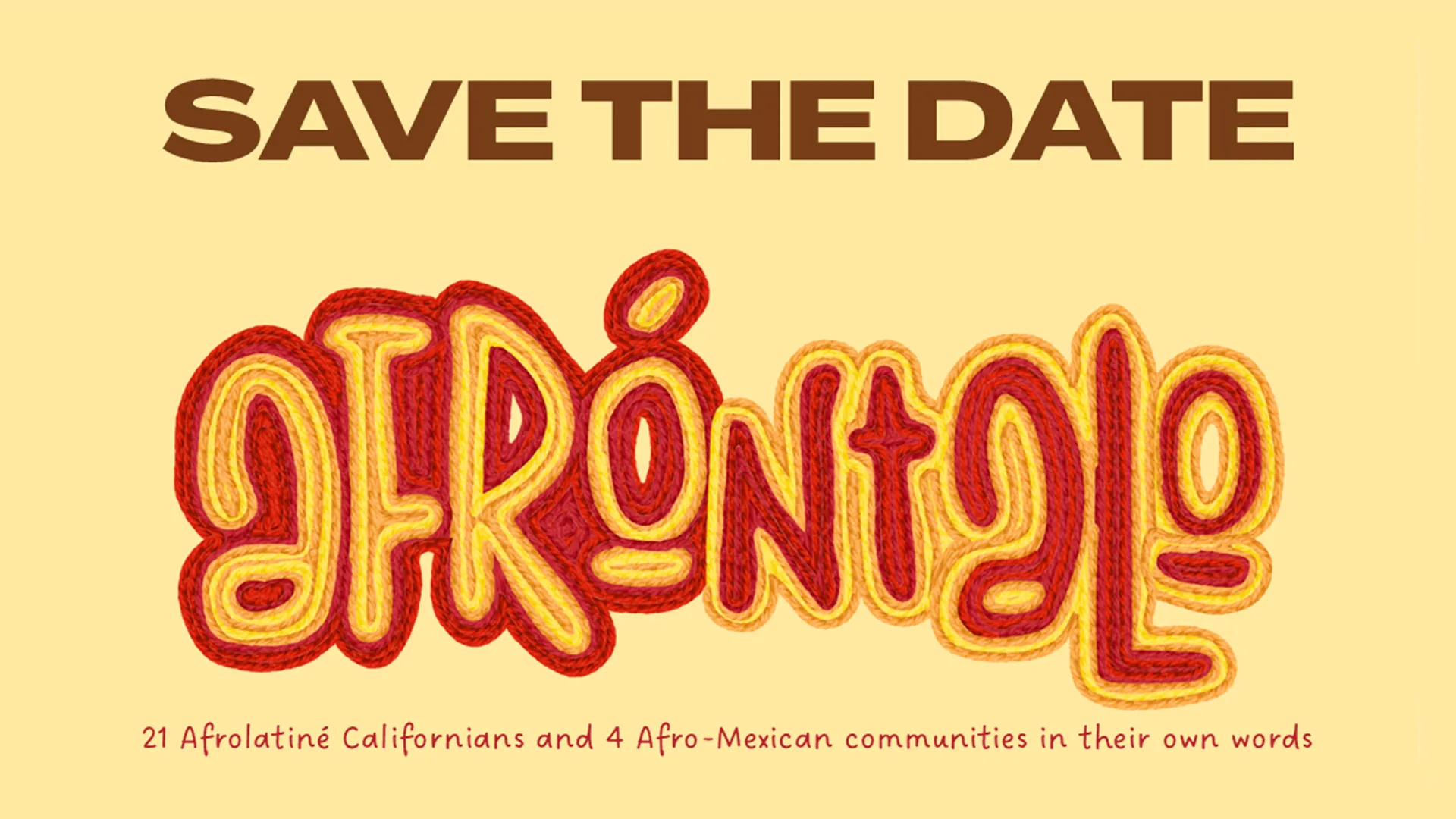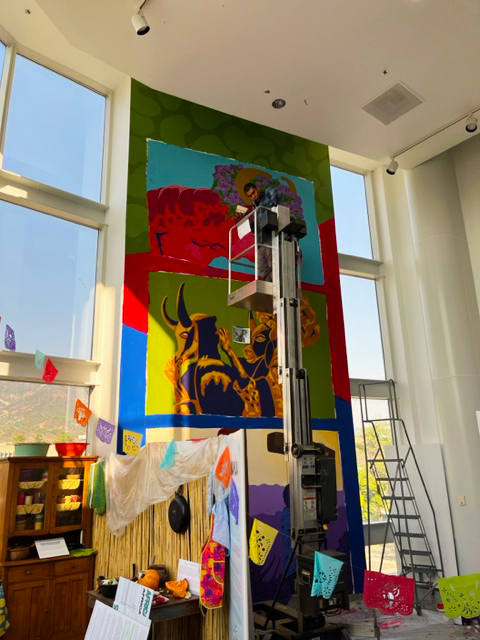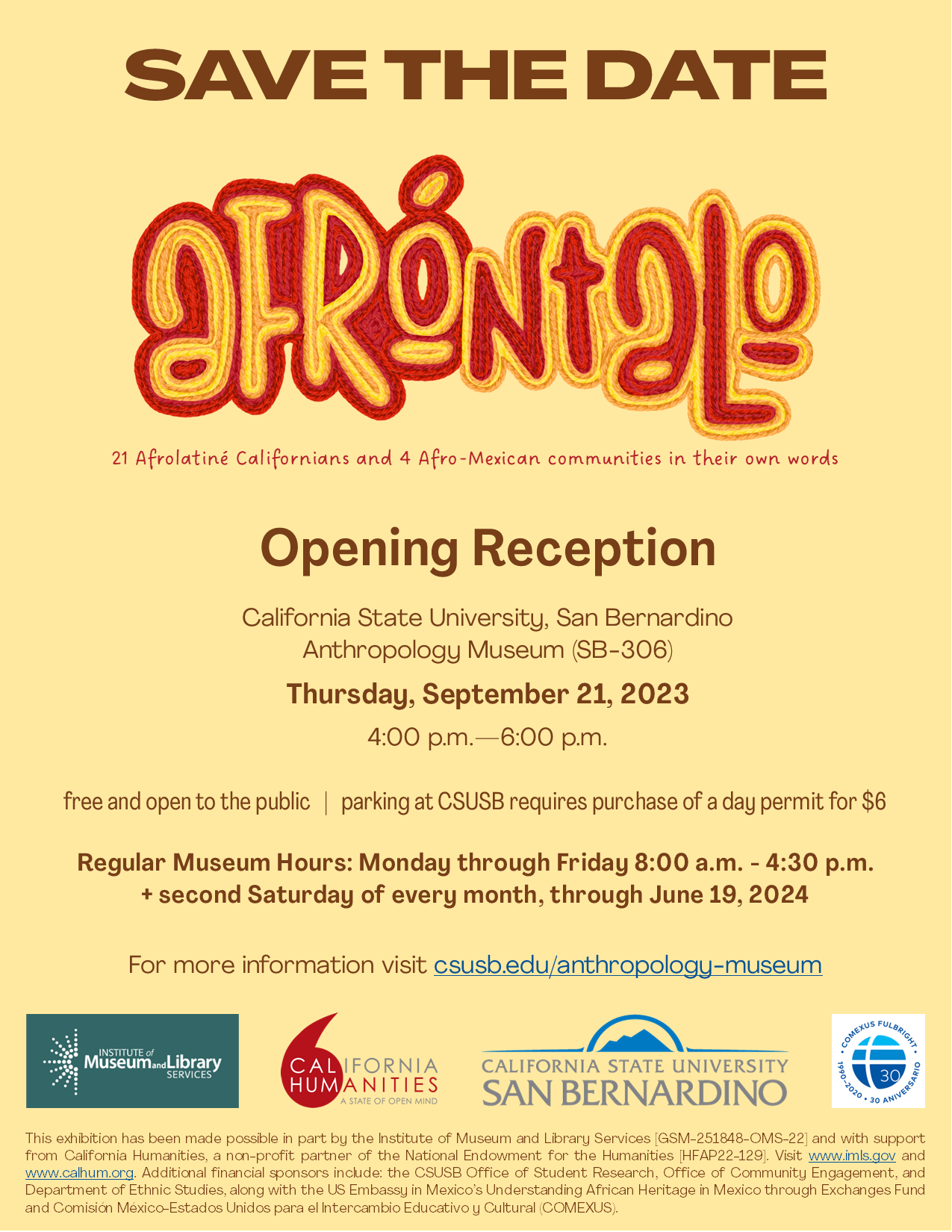

The histories, cultures and identities of Afrolatines are the focus of “Afróntalo,” a new exhibition at the Anthropology Museum at Cal State San Bernardino. The museum will host an opening reception from 4-6 p.m. Thursday, Sept. 21.
The museum is located on the third floor of the university’s College of Social and Behavioral Sciences building, in room 306. The exhibition will run the full 2023-24 academic year, and is scheduled to close on June 19.
“One in four Latin Americans has African ancestry,” the exhibition’s introductory panel states on a 10-foot tapestry crafted by CSUSB student Alessandro Corsaro. “And yet, there is a general deficit of knowledge regarding the presence and prevalence of blackness throughout the Americas. This is more than a simple matter of obscurity. It is a problem of erasure, invisibility and dislocation. Afróntalo introduces you to four communities in Mexico and twenty-one Californians, all in their own words, to explore the depth and breadth of Afrolatine histories, cultures and identities.”
The exhibition features two sections: one curated by representatives of four Afro-descendant communities in Mexico, and another presenting biographies and original portraits of 21 Afrolatine Californians. Introductory text for both sections provides historical information, curated by CSUSB student Evy Zermeno. A stunning two-story mural, painted by muralist Julio “Honter” Antuna Lopez, can be seen throughout the exhibition.

The four communities that partnered with the Anthropology Museum to bring this exhibition to life are: Tamiahua (Veracruz state, lead curator Doris Careaga-Coleman), Coyolillo (Veracruz state, lead curator Daniela Carreto López), the Negros Mascogos (Coahuila state, lead curator Karla Rivera Tellez), and the Costa Chica region (Oaxaca and Guerrero states, lead curator Sergio Navarrete Pellicer).
Lead curators and their teams were trained in curation and exhibition development by María Fernanda Yáñez Uribe from Museo de Arte Popular in Mexico City.
Each curatorial team chose their own focus for the exhibition. For Tamiahua, the focus is cuisine, cooking, fishing and connecting community traditions to Africa and other Afro-descendant communities in the Americas. The Coyolillo portion focuses on the joys of the community and Blackness. For the Costa Chica community, the focal point is three Afrodescendant dances from the region. As for the Negros Mascogos, the exhibit follows the history of enslaved Afrodescendants who made their way to Mexico.
Representatives from all four partner communities will be present for the opening reception. They will also participate in programming from Sept. 18-21, delivering guest lectures that include a discussion of the Afrochicanx Oral History Project, Africa in the history of Mexican music, and the history of the Black Mascogos. The curatorial team from Coyolillo will also participate in a panel discussion on migration and U.S. immigration policies, hosted by the university’s Undocumented Student Success Center and moderated by Rosario Rizzo Lara, assistant professor of sociology.
A full list of programming is available on the Anthropology Museum website.
While Sept. 21 marks the opening of the exhibition, work on it has been underway for more than two years. In May 2022 the museum hosted “Developing Afro-Latinx Infused Curriculum,” a bilingual teaching symposium for educators, focused on infusing Afro-Latinx content into K-12 teaching. The event was a partnership with the museum, the CSUSB Ethnic Studies Program, San Bernardino High School and San Bernardino City Unified School District Multilingual Programs. It was sponsored by the CSUSB Office of Community Engagement and inspired by the Fulbright Hays Seminar Abroad Program 2021 “Exploring African Heritage in Mexico” hosted by Comisión México Estados Unidos para el Intercambio Educativo y Cultural (COMEXUS).
In February 2023 the museum hosted a two-day celebration of Oaxaca’s Afrodescendant heritage at the Garcia Center for the Arts in San Bernardino. The event showcased the history, heritage, art, food, dance and music of the coastal region of Oaxaca.
Museum hours are 8 a.m.-4:30 p.m. Monday through Friday. During the run of Afróntalo, the museum will also be open the second Saturday of each month.
The exhibition has been made possible in part with grants from California Humanities, the Institute of Museum and Library Services and the U.S. Embassy in Mexico’s Understanding African Heritage in Mexico through Exchanges Fund. Additional sponsors of opening week celebration programming include: The College of Social and Behavioral Sciences Office of the Dean, the Division of Student Affairs, the College of Extended and Global Education, the Office of the Provost, the Department of Art and Design, the College of Arts and Letters Office of the Dean, the Department of Theatre Arts, Los Amigos Spanish Club, and University Advancement.
